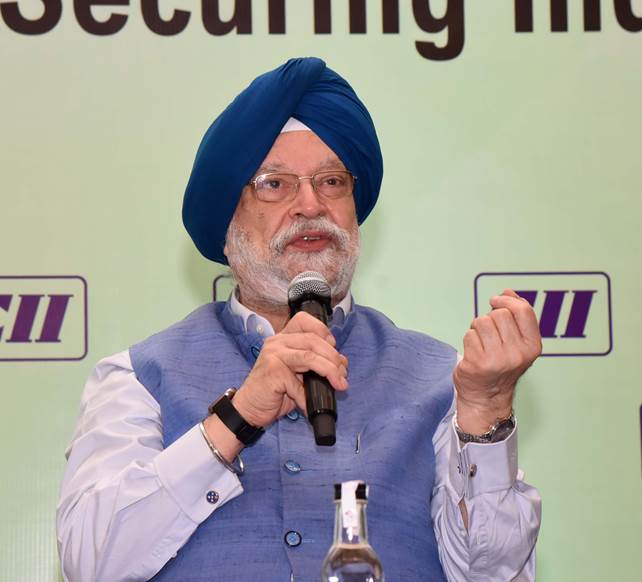
At the 12th Edition of the CII Bioenergy Summit, Hardeep Singh Puri, Minister of Petroleum and Natural Gas, underscored India’s remarkable progress in bioenergy, aligning with the summit’s theme, “Fuelling the Future – Securing India’s Green Growth Goals.”
Puri highlighted the success of India’s ethanol blending initiative, which has seen the blending percentage rise from 1.53% in 2014 to a projected 15% by 2024.
Encouraged by these results, the government has advanced its target for 20% blending to 2025, reinforcing its commitment to sustainable energy. He further revealed that discussions have already started to develop a roadmap for the future, post the attainment of the 20% blending target.
This roadmap will guide the country’s next steps in its pursuit of energy sustainability and self-reliance.
Shri Hardeep Singh Puri commended Prime Minister Narendra Modi’s leadership in transforming India’s bioenergy ecosystem since 2014.
He emphasized the crucial role of market dynamics, technology advancements, and supportive government policies in driving this transformation and enhancing sustainability in the energy sector.
The Minister shared impressive outcomes of the ethanol program, revealing that from 2014 to August 2024, it has generated foreign exchange savings of ₹1,06,072 crore, reduced CO2 emissions by 544 lakh metric tons, and achieved crude oil substitution of 181 lakh metric tons.
Payments to distillers by OMCs have reached ₹1,50,097 crore. Furthermore, he said, farmers have been paid ₹90,059 crore, empowering them from being Annadata to being Urjadata.
Additionally, he mentioned about the government’s ambitious targets for Sustainable Aviation Fuel (SAF), aiming for 1% blending in 2027 and 2% in 2028, positioning India as a leader in bio-mobility.
At the event, Hardeep Singh Puri emphasized India’s robust economic growth, predicting it will drive 25% of global energy demand over the next two decades.
He noted that bioenergy will be crucial in meeting this demand while advancing climate goals and rural development.
Currently valued at US$44 billion (as per Wood Mckenzie), the Minister said that the bioenergy market is projected to grow to US$125 billion by 2050. If global net-zero targets are achieved, this figure could surge to US$500 billion.
Underscoring India’s agricultural strength and its vast biomass potential as critical elements in the country’s transition to clean energy,
Puri said that the country recognized as an agricultural powerhouse, is a leading producer of rice, wheat, cotton, sugar, and various horticultural and dairy products.
He said that the country has more than 750 million metric tonnes of available biomass, with about two-thirds being used for domestic purposes such as cattle feed and compost fertilizer.
According to a report by PWC, he noted, 32% of India’s total primary energy consumption is derived from biomass, and over 70% of Indians rely on it for energy across the value chain.
India’s position as a major biofuel producer and consumer has been strengthened through coordinated policies, political support, and abundant feedstocks, said Shri Hardeep Singh Puri.
He noted that the International Energy Agency (IEA) forecasts a growth potential of 3.5 to 5 times for biofuels by 2050 due to Net Zero targets, presenting a substantial opportunity for India.
The Global Biofuels Alliance (GBA) aims to facilitate knowledge sharing, technological advancement, and policy development, unlocking a $500 billion opportunity in biofuels and accelerating global adoption through technology transfer.
He said that the government initiatives, such as the Indian Solar Alliance (ISA) and GBA, aim to accelerate the transition to cleaner energy sources, reduce import dependency, save foreign exchange, promote a circular economy, and move toward a self-reliant energy future.
The Minister also referred to different incentives introduced by government to support ethanol production.
Puri also highlighted India’s collaboration with Brazil, emphasizing the importance of joint efforts in sustainable bioenergy and biofuels to enhance energy security and reduce carbon emissions, particularly in hard-to-decarbonize sectors like aviation and shipping.
In his concluding remarks, Hardeep Singh Puri emphasized that the responsibility for fuelling India’s green growth extends beyond the government to include industry leaders, researchers, innovators, and citizens.
He urged all stakeholders to collaborate boldly to establish a sustainable bioenergy sector that meets energy needs and sets a global standard.




